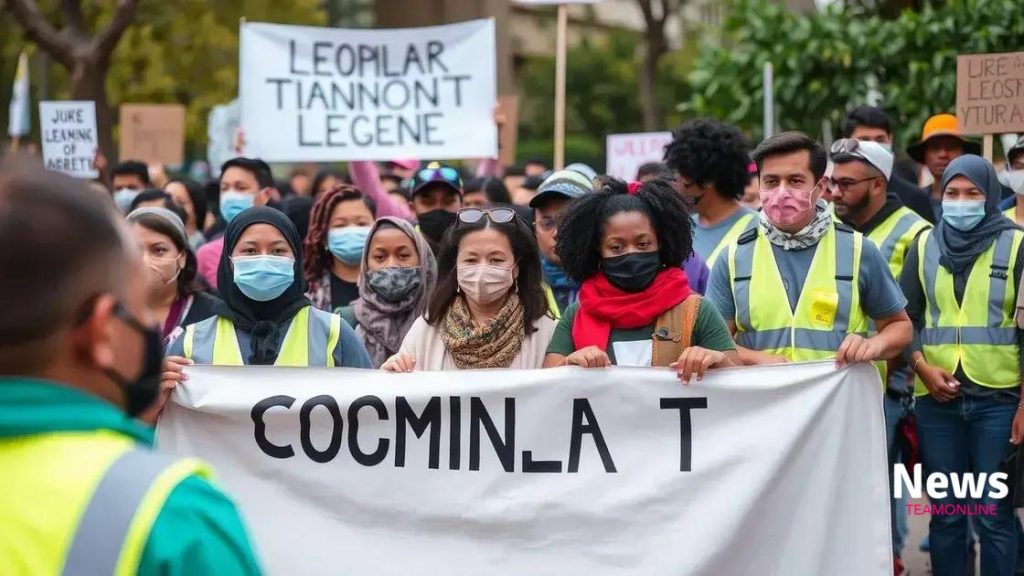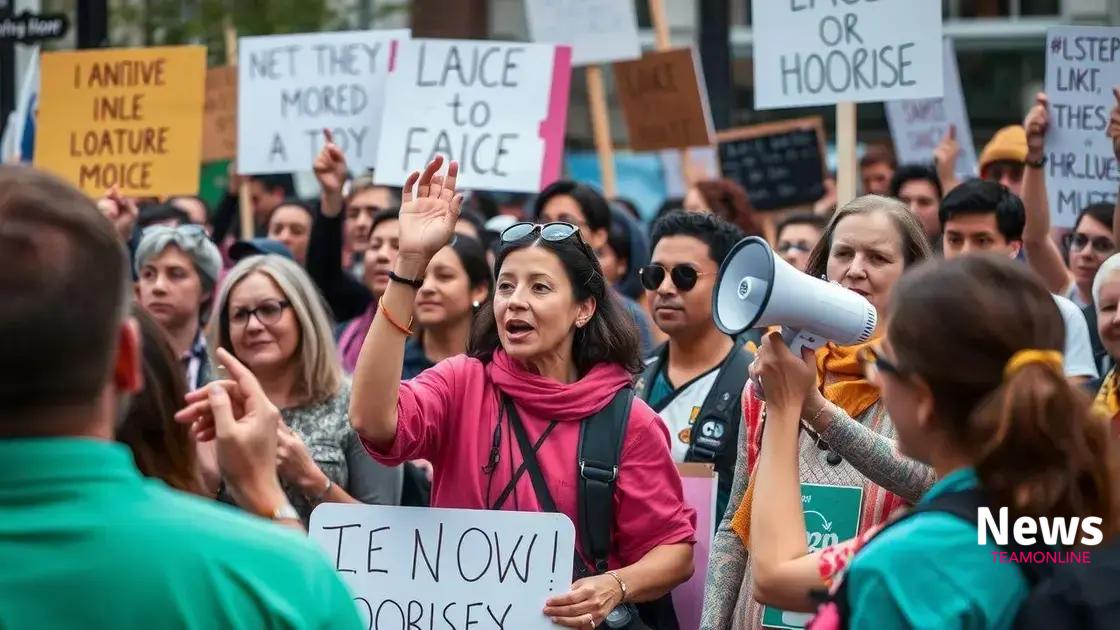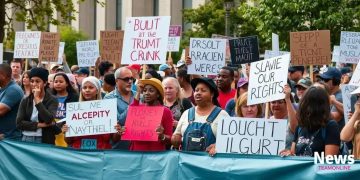Community-led protest safety plan: how to stay safe

A community-led protest safety plan is crucial for ensuring participant safety and effective communication, encompassing emergency protocols, designated roles, and collaboration with local organizations.
Community-led protest safety plan initiatives are essential in ensuring a secure environment during demonstrations. But how can you protect yourself and others? Let’s dive into effective strategies that can make all the difference.
Understanding the importance of safety in protests
Understanding the role of safety in protests is crucial for everyone involved. When large groups gather to express their views, ensuring safety helps participants focus on their message without fear. Safety measures protect not only individuals but also the integrity of the protest itself.
One great way to enhance protest safety is through community involvement. When people come together to form a plan, they create a culture of awareness and preparedness. This collective effort can lead to effective strategies that cater to the unique needs of the group.
Key reasons for prioritizing safety
Here are some important aspects of protesting safely:
- Minimizes the risk of confrontation with opposing factions.
- Prepares participants for unexpected situations.
- Encourages positive interactions with law enforcement.
- Creates a supportive environment for expressing views.
In addition, effective communication plays a significant role in maintaining safety at protests. Clear directions and updates help participants remain informed and make better decisions. It’s essential to designate individuals responsible for relaying information and guiding attendees during the event.
Building a supportive community
By fostering a supportive community, protesters are more likely to feel empowered and secure. Communities should work together to establish connections and resources, making sure everyone feels included. This commitment to safety can lead to stronger bonds among members, which in turn can lead to more impactful protests.
Ultimately, understanding the importance of safety in protests can lead to a successful demonstration, one that effectively conveys its message without compromising on security. Taking simple steps to enhance safety allows participants to focus on the cause and express their views freely.
Key elements of a community-led protest safety plan
Creating a community-led protest safety plan involves several key elements that work together to ensure the safety of all participants. A well-structured plan not only enhances safety but also fosters a sense of unity among protesters.
Effective communication
One of the most crucial elements is effective communication. It is vital to establish clear lines of communication among organizers and attendees. This can include:
- Designating safety monitors who can relay information during the protest.
- Using social media to provide real-time updates.
- Creating a group chat where participants can share information.
When everyone is on the same page, it greatly reduces the chances of misunderstandings or confusion during the protest. Such preparation keeps everyone informed of any potential dangers.
Safety roles and responsibilities
Another essential aspect is assigning safety roles to different group members. Each person should have specific responsibilities, which may include:
- First aid responders to assist anyone who gets injured.
- Coordinators to direct people during the protest.
- Monitors to ensure participants remain peaceful.
When individuals know their roles, the protest runs more smoothly and everyone can focus on the cause without worrying about safety issues.
Planning for various scenarios is also vital. Organizers should anticipate things like inclement weather, potential interference from opposing groups, or visits from law enforcement. Having a response plan for these situations can significantly enhance the safety of the entire event.
Emergency contacts and resources
Lastly, knowing who to contact in case of emergencies is crucial. Be sure to establish a list of emergency contacts, which should include:
- Local medical facilities for quick access to healthcare.
- Liaison officers from law enforcement for communication.
- Legal contacts who can provide advice if needed.
By having these resources readily available, the community can act quickly if any issues arise during the protest.
How to communicate effectively during a protest

Communicating effectively during a protest is essential for maintaining safety and ensuring everyone’s voices are heard. Clear communication can make a significant difference in how a protest is perceived and how smoothly it runs.
Establishing a communication plan
Having a solid communication plan is key to a successful protest. This ensures everyone knows how to share information. Organizers should consider:
- Creating a group chat or messaging platform for instant updates.
- Using megaphones or loudspeakers to relay important announcements.
- Appointing leaders who can communicate directly with the crowd.
It’s important that everyone is on the same page, especially when quick decisions need to be made during the protest.
Active listening techniques
Active listening is another crucial aspect. Participants should be encouraged to listen and engage with one another respectfully. Some ways to promote this include:
- Encouraging questions and open dialogue among participants.
- Promoting a culture of respect and understanding different perspectives.
- Validating others’ feelings and opinions during discussions.
By fostering an environment of active listening, protests can become more inclusive and effective in conveying messages.
Using social media is a powerful tool to enhance communication. Throughout the protest, organizers can share live updates, safety tips, and important messages with attendees. This not only keeps the crowd informed but also creates a broader awareness among supporters who may not be physically present at the protest.
Non-verbal communication
Non-verbal communication also plays a significant role in protests. Gestures, signs, and body language can convey powerful messages without words. People should be aware of their surroundings and use non-verbal cues to express solidarity and connection. This includes:
- Using appropriate hand signals to communicate silently.
- Creating visually compelling signs that convey strong messages.
- Staying connected with others through eye contact and body language.
By focusing on both verbal and non-verbal methods of communication, participants can ensure that everyone feels connected and informed during the protest.
Steps to prepare for potential challenges
Preparing for potential challenges during a protest is essential to ensure safety and effectiveness. By taking proactive steps, organizers can equip participants with the tools necessary to handle various situations.
Identifying possible challenges
First, it is important to identify potential challenges that may arise during the protest. These can include:
- Inclement weather that could disrupt the event.
- Opposing groups that may clash with protesters.
- Intervention from law enforcement that could escalate tensions.
- Medical emergencies requiring immediate attention.
By anticipating these challenges, organizers can create effective strategies to manage them appropriately.
Developing an emergency plan
Having a well-thought-out emergency plan is crucial. This plan should outline specific actions to take if a challenge occurs. Essential components of the plan include:
- Establishing safe zones where participants can regroup.
- Designating individuals responsible for communicating during crises.
- Creating a network of medical responders ready to assist if needed.
When everyone understands the plan and their role within it, responses to challenges are more efficient and effective.
Another key aspect is conducting training sessions. Organizers should host workshops before the protest to ensure that participants understand the challenges and know how to react. This can help build confidence and reduce panic during a real situation.
Establishing communication protocols
Establishing solid communication protocols is critical as well. Clear lines of communication allow organizers and participants to share important information quickly. Consider implementing:
- Hand signals to alert others without shouting.
- Pre-arranged meeting points if the group gets separated.
- Access to walkie-talkies or mobile apps for instant updates.
Effective communication minimizes confusion, helping everyone to stay informed and secure.
Lastly, reviewing the safety plan regularly is essential for any successful protest. Organizers should meet before the event to discuss updates and make changes based on recent events or feedback.
Building a supportive network for protest safety
Building a supportive network for protest safety is essential for creating a secure environment during demonstrations. A network ensures that all participants feel safe and supported while expressing their views.
Forming alliances
One of the first steps in building this network is forming alliances with local organizations. These groups may include:
- Community centers that can provide resources and support.
- Legal aid organizations that offer advice and assistance.
- Healthcare providers who can help with medical emergencies.
By partnering with these organizations, groups can broaden their support base and ensure appropriate resources are available during the protest.
Training and resources
Training volunteers is also a key aspect of building a supportive network. Providing workshops on:
- De-escalation techniques to handle tense situations.
- First aid practices for immediate medical response.
- Communication skills to effectively coordinate during the protest.
Trained volunteers can act as safety monitors, keeping an eye on the crowd and helping resolve any issues that arise calmly.
Moreover, creating a resource guide that includes contact information for local services can help keep everyone informed. This guide should provide:
- Navigational tips for safe routes to and from the protest.
- Emergency contacts for law enforcement and medical services.
- Information about designated meeting points in case of separation.
With these resources readily available, participants are better prepared to face challenges during the protest.
Encouraging community involvement
Encouraging community involvement is essential for strengthening the network. Engaging diverse groups in planning and executing the protest can foster inclusivity. This helps ensure that everyone feels valued and heard. Community-focused events leading up to the protest can also build momentum and enhance participation.
Lastly, open communication via social media platforms can help create a connected community. Regular updates and discussions about safety strategies will further solidify the supportive network, ensuring that everyone is informed and ready to stand together safely during the protest.
FAQ – Frequently Asked Questions about Community-Led Protest Safety
Why is a safety plan important for protests?
A safety plan is crucial because it helps protect participants and ensures that the protest message is heard without unnecessary risks.
What should be included in a protest safety plan?
A protest safety plan should include communication strategies, emergency contacts, designated roles, and training for volunteers.
How can participants prepare for unexpected challenges during a protest?
Participants can prepare by understanding potential challenges, knowing emergency protocols, and being briefed on safety measures before the event.
What is the role of community organizations in protest safety?
Community organizations can provide resources, training, and support, enhancing overall safety and the effectiveness of the protest.





